Moniek Bloks's Blog, page 185
March 27, 2020
Catherine Parr – The reluctant Queen (Part two)
Their wedding took place on 12 July 1543 at Hampton Court, and Catherine was now Queen of England. Always a practical woman, she tried to make the best of the situation and to make the most of the opportunities she now had. Catherine appointed close friends and family to her household, like her sister Anne and her stepdaughter Margaret. Her devotion to religious reform remained and could also be found in her household. Catherine was also determined to show herself as a Queen and ordered many fine fabrics.
Catherine also gained two more stepdaughters (and a stepson) by her marriage to Henry, but she and Mary were more friends than mother and daughter. They were fond of each other, despite their religious differences. She also corresponded with Elizabeth regularly, but Elizabeth spent less time at court after she fell out of favour with her favour for nearly a year. She was recalled to court in the summer of 1544. Catherine became the binding force between Henry’s three children and perhaps for the first time; they had a family life. In July 1544, Catherine was left as regent of England as Henry set off for war in France. He returned home by the end of September. In March 1545, Catherine’s stepdaughter Margaret died. She had cared for her since she was a young child and probably viewed her as her own daughter. The cause of her death was not recorded, but Margaret left a will in which she lovingly referred to Catherine.
Catherine’s reformist view nearly cost her her life during her Queenship. Even though Henry had declared himself Supreme Head of the Church of England, he was still a conservative in many ways. Catherine published Prayers or Meditations in 1545, becoming the first Queen of England to be a published author in her own right. She must have secured Henry’s permission first, or it would never have been released so he must have read or at least approved of the contents. The following year, her more radical work – The Lamentation of a Sinner – was completed. Henry found that Catherine’s beliefs went much further than his own, and he became concerned.
In early 1546, Anne Askew was arrested and interrogated. A second arrest in May followed, and she was asked to name other heretics. The interrogators asked about specific people – members of Catherine’s household. Anne refused to incriminate the other women, and she was put on the rack. Anne held on and so no more, but her fate was sealed.
Meanwhile, Henry was becoming impatient with Catherine and her religious discussions. Catherine was criticised for attempting to change his mind, and Henry became even more suspicious. Henry gave his consent to have Catherine arrested, and while preparations were being made, Catherine continued to discuss religious matters with Henry – unaware of the danger she was in.
Catherine finally received a tip-off and learned of the plot against her. Her apparent screams and cries alerted the doctor, who told her everything he knew of the plot and advised her to submit to her husband. Shortly afterwards, Henry visited Catherine, and she explained that her sudden illness was due to a fear that Henry, “had taken displeasure with her, and had utterly forsaken her.” When Henry left, Catherine ordered her ladies to remove all the forbidden books and the following day she submitted herself.
“If your majesty take it so… then hath your majesty very much mistaken me, who have ever been of the opinion, to think it very unseemly, and preposterous, for the woman to take upon her the office of an instructor or teacher to her lord and husband; but rather to learn of her husband, and to be taught by him. And whereas I have, with your majesty’s leave, heretofore been told to hold talk with your majesty, wherein sometimes in opinions there hath seemed some difference, I have not done it so much to maintain opinion, as I did it rather to minister talk, not only to the end your majesty might with less grief pass over this painful time of your infirmity, being attentive to our talk, and hoping that your majesty should reap some ease thereby; but also that I, hearing your majesty learned discourse, might receive to myself some profit thereby: wherein, I assure your majesty, I have not missed any part in my desire in that behalf, always referring myself, in all such matters, unto your majesty, as by ordinance of nature it is convenient for me to do.”
Henry was satisfied with her submission and said they were “perfect friends” again. Catherine had averted a sure death sentence. She learned not to be so open about her religious beliefs and opinions. For Anne Askew, there was no such mercy. On 16 July 1546, she had to be carried to the stake (due to the torture inflicted upon her on the rack) to be burned for heresy.
By the end of 1546, it was clear that Henry’s health was failing. He was unwell around Christmas, and he sent Catherine away because of this. She spent Christmas 1546 at Mary’s household at Greenwich. She would never see her husband again. He died in the early hours of 28 January 1547 and was succeeded by his young son, now King Edward VI. His death was not announced until 31 January. Thomas Seymour had also returned to England, and as an uncle to the new King, he was raised to the peerage as Baron Seymour of Sudeley. As a Dowager Queen, it was expected of Catherine to leave the court and preparations were being made by March. Catherine was made guardian of Elizabeth, and together they moved to one of her dower houses at Chelsea.
Thomas renewed his interest in Catherine in early 1547, and they were soon writing to each other. By early May, they were betrothed, but she wanted to have a decent period of mourning before getting married again. But she could not hide her happiness and told her sister of everything that happened. Her ideas of a proper mourning period were later disregarded, and she and Thomas were married sometime in late May or early June. Catherine could still have technically been unknowingly pregnant with the King’s child, and this could have endangered the succession if there had been doubt as to the child’s paternity.
By early July, the marriage became public knowledge, and they faced a severe backlash for it. Mary was furious with her stepmother and Thomas’ elder brother – the Lord Protector – was also angry. Catherine’s relationship with Mary was never the same again, and she began to doubt her suitability as a guardian for Elizabeth. Nevertheless, Elizabeth remained in her household and was even joined there by Lady Jane Grey, who was Thomas’ ward. When Thomas began to behave himself indecently towards Elizabeth, Catherine was initially oblivious but was later heartbroken. Catherine grew uneasy with her husband’s behaviour, but she found herself in changed circumstances. For the first time in four marriages – she was pregnant.
It was not to be a happy and healthy pregnancy. Catherine was often ill and uncomfortable. Meanwhile, the situation between Elizabeth and Thomas escalated to such an extent that Catherine was forced to send Elizabeth away. Catherine believed herself to be negligent and did not blame Elizabeth for what had happened. As time went on, Catherine became more excited about her upcoming motherhood and nicknamed the baby, “the little knave.” By June, Catherine and her household moved to Sudeley Castle to get away from the heat and the disease that plagued the capital.
On 30 August 1548, Catherine gave birth to a daughter named Mary. Her stepdaughter Mary acted as godmother for her namesake, and all frostiness over the marriage seemed over. Catherine seemed to recover well from the birth, but by 3 September, she was dangerously ill. In her delirium, she accused her husband of cruelty towards her. Between 2 and 3 o’clock in the morning of 5 September, Catherine passed away at the age of 36.
Catherine was buried in the chapel of Sudeley Castle in a royal funeral in accordance with the reformed rites of the church. The 10-year-old Lady Jane Grey acted as chief mourner. Little Mary went to live in the household of the Duchess of Suffolk, but the child was a burden to her. In 1550, she was granted money for household wages, uniforms and food, but then she disappeared. She most likely died in childhood.1
The post Catherine Parr – The reluctant Queen (Part two) appeared first on History of Royal Women.
March 26, 2020
Catherine Parr – The reluctant Queen (Part one)
Catherine Parr was born in 1512 as the daughter of Sir Thomas Parr of Kendal and Maud Green. She was their second child but the eldest surviving one, as her elder brother did not long survive his birth. She was named for the Queen – Catherine of Aragon. The exact date of her birth is not recorded, nor is the place. A younger brother named William was born in 1513, followed by a younger sister named Anne in 1515.
Most of her childhood was spent at her parents’ home in Blackfriars. Her father became a fixture at King Henry VIII’s court while her mother would eventually become one of Queen Catherine’s ladies. Catherine was still only five years old when her father died, but her mother never remarried. Maud was rarely at home during Catherine’s childhood, but her children did grow up in a household maintained by her. Details of her education have not survived, but others considered sending their children to Maud’s household so it must have been pretty good. We know that Catherine spoke French fluently and also read and understood Latin. She also knew some Greek, Italian and Spanish.
Catherine was described as having “a lively and pleasing appearance” but Anne of Cleves – who has gone down in history as the “ugly” wife – would comment that she was much more beautiful than Catherine. Maud had ambitions for her eldest daughter and was already contemplating marriage for her when she was 11 years old. The intended husband was Henry Scrope – the heir of Lord Scrope of Bolton. The match eventually fell through, and Maud first focussed on William’s match with one of the most sought after heiresses in England – Anne Bourchier, the only child of the Earl of Essex. They were married in 1527.
This match came at a high cost for Catherine as it left for her little as a dowry. Her mother eventually settled on Edward Burgh, the eldest son and heir to Sir Thomas Burgh, 1st Baron Burgh and Catherine married him in 1529. Catherine had been raised a Catholic, but it is likely that she became a reformer during her first marriage. By the spring of 1533, Catherine’s husband was dead, and she was left with a small pension to support herself. By then, her ambitious mother had also passed away.
Her sister Anne managed to secure herself a place with the Queen – by then Anne Boleyn – and she went on to serve all of Henry’s subsequent wives. Perhaps Catherine also hoped to have a position at court, but her whereabouts during her first widowhood are unknown. Before the end of the year, Catherine had secured a second match – with John Neville, Lord Latimer. He had been married and widowed twice before, and he had two children. He was 19 years older than her. The relationship with her stepson John was complicated, but she became close to her stepdaughter Margaret. She supervised Margaret’s education personally and instilled in her the same reformist beliefs. Catherine was now running her own household – something that she had not been able to do while living with her first husband’s family.
Her husband was implicated in the Pilgrimage of Grace in 1536, and he was taken to the Tower, accused of rebellion against the King. He continued to maintain that he had acted under duress and he was eventually able to secure his release. From 1537 on, Catherine and her husband spent a considerable amount of time in London. Her brother had made a name for himself and became a peer in his own right in 1539. Catherine probably met the King for the first time in 1540.
Catherine became a widow for the second time in 1543, though the exact date is not recorded. She was close by when he died, and she arranged his burial in St Paul’s Cathedral. She was left a rich widow – with the income of two manors and the guardianship of Margaret. Catherine kept her household in London with her stepdaughter, and she was hoping that she might be able to marry for love this time around. She was in love with Thomas Seymour, the brother of King Henry VIII’s third wife – Jane Seymour. Jane had died in 1537 after giving birth to the future King Edward VI. Catherine became attached to the future Queen Mary I’s household in 1543 when she came to court to act as his hostess because he found himself without a Queen.
Catherine fully intended to marry Thomas Seymour once her period of mourning was done, but suddenly there was another contender for her hand – the King himself. He may have been a King, but he was certainly no catch. By 1543, he was obese and, an invalid with an ulcer in his leg. After the disappointment that Catherine Howard had been, he had made it treason for a non-virgin to marry the King. However, he soon realised this narrowed the field somewhat, and he resolved to marry a widow who could not be expected to be a virgin. Catherine was also apparently infertile, having had no children with her first two husbands. Yet, Henry remained hopeful of further issue; he had accepted that it wasn’t likely to happen. Catherine was probably deeply disturbed by the King’s interest in her and tried to discourage him. Thomas Seymour was conveniently shipped out to act as an ambassador to the Netherlands.
Even when Henry finally proposed to her, Catherine defiantly told him that “it were better to be your mistress than your wife.” It only made Henry more convinced that she was the perfect bride. He then told her, “Lady Latimer, I wish you to be my wife.” Catherine now had no choice. She fell to her knees and answered, “Your Majesty is my master, I have but to obey you.”1
Part two coming soon.
The post Catherine Parr – The reluctant Queen (Part one) appeared first on History of Royal Women.
March 25, 2020
Royal Witches: From Joan of Navarre to Elizabeth Woodville by Gemma Hollman Book Review
The stories of Joan of Navarre, Elizabeth Woodville, Jacquetta of Luxembourg and Eleanor Cobham have been overshadowed by accusations of witchcraft.
Joan of Navarre was born around 1368 as the daughter of King Charles II of Navarre and Joan of France. Her first marriage was to John IV, Duke of Brittany and they went on to have eight children together, though not all would live to adulthood. Joan was widowed on 1 November 1399, and she was left as regent of Brittany for her minor son. By then, she had already met the man who would become her second husband, and it is likely to have been a love match. On 2 April 1402, Joan married the future King Henry IV of England by proxy, but she was widowed again in 1413. On 27 September 1419, Joan, who had always been on good terms with the new King, was deprived of all her possessions and revenue and four days later, she was arrested on charges of witchcraft. The charges were probably an attempt at claiming her wealth and Joan had no actual dealings with witchcraft. When Henry V lay dying in 1422, he ordered that she be released and have her goods returned to her. Joan resumed her life as a wealthy widow. She is recorded as having gone on a pilgrimage to Walsingham in 1427 but virtually disappears from the records otherwise.
Elizabeth Woodville and her mother Jacquetta of Luxembourg were both accused of witchcraft. Jacquetta had previously been to John, Duke of Bedford, brother of King Henry V before marrying Sir Richard Woodville, Elizabeth’s father. Elizabeth had two children with her first husband Sir John Grey of Groby before he was killed at the Second Battle of St Albans. Though the meeting of Elizabeth and the new King Edward IV has been romanticised by series such as the White Queen, we do not know exactly when and where they met or when the King decided to marry her to the surprise of many. They went on to have ten children together, though not all would live to adulthood. Edward IV died in 1483, and their two sons disappeared from the Tower of London. With Edward’s brother declared King Richard III, Elizabeth fled into sanctuary. Richard III revived the allegations of witchcraft against the then dead Jacquetta when he claimed that she and Elizabeth had procured Elizabeth’s marriage to Edward IV through witchcraft. Elizabeth would emerge somewhat victorious when her eldest daughter married King Henry VII of the Tudor Dynasty.
Eleanor Cobham was born around 1400, probably in Kent, England, as the daughter of Reginald Cobham, 3rd Baron Cobham, and his wife, Eleanor Culpeper. Eleanor first appeared on the scene in the early 1420s, when she was a lady-in-waiting for Jacqueline of Hainaut, the wife of Humphrey, Duke of Gloucester. Humphrey was the fourth and youngest son of King Henry IV of England. His oldest brother, Henry V of England, died in 1422, leaving behind an infant son, Henry VI. Humphrey left Jacqueline in 1425. Around this time, Eleanor became his mistress. Humphrey and Eleanor married sometime between 1428 and 1431. It was later alleged that Eleanor used witchcraft to get the duke to fall in love with her. In 1441, she was arrested and admitted that she was using services from Margery Jourdemayne, known as “the Witch of Eye”. These services included seeking a potion to help her conceive. Eleanor was found guilty of witchcraft and sorcery and was sentenced to do public penance and imprisonment. She died on 7 July 1452.
Royal Witches: From Joan of Navarre to Elizabeth Woodville by Gemma Hollman tells you these women’s stories from the witchcraft angle, and it shows only all too well how witchcraft accusations could destroy a woman’s life and take away any credibility and power she had. It is well-researched and easy to read as it also included the backstories of the women. I would highly recommend it.
Royal Witches: From Joan of Navarre to Elizabeth Woodville by Gemma Hollman is available now in the US and the UK.
The post Royal Witches: From Joan of Navarre to Elizabeth Woodville by Gemma Hollman Book Review appeared first on History of Royal Women.
March 24, 2020
Princess Charlene of Monaco – From swimmer to Princess
Charlene Lynette Wittstock was born on 25 January 1978 as the daughter of Michael and Lynette Wittstock. She was born in Bulawayo, Rhodesia, now known as Zimbabwe. She is the eldest of three siblings, and her two younger brothers are Gareth (born 1980) and Sean (born 1983). When Charlene was 12 years old, the family moved to South Africa where she attended the Tom Newby Primary school in Benoni.
Embed from Getty Images
Charlene developed a love for swimming from a very early age. She became a competitive swimmer, and at the age of 18, she won the South African Championships. At the 1999 All-Africa Games in Johannesburg, she won three gold medals and one silver medal. She competed in the 1998 and 2002 Commonwealth Games for South Africa and won a silver medal in the 4×100 metre medley relay in the 2002 games. In 2000, Charlene competed in the Summer Olympic Games in Sydney. She was in the women’s 4×100 metre medley team, which ended up in fifth place. Later that same year, she won the gold medal for the 200-metre backstroke event at the Marenostrum international swimming meeting in Monaco. This is also where she would meet her future husband for the first time as he was presiding over the competition. At the time Albert was known as The Hereditary Prince of Monaco.
Embed from Getty Images
Embed from Getty Images
Charlene continued her career in swimming until 2007. Her relationship with Prince Albert – who succeeded his father of Prince of Monaco in 2005 – became public in 2006. They were seen together at the opening ceremony of the 2006 Winter Olympics, and she moved to Monaco. On 23 June 2010, their engagement was announced by the Prince’s Palace. Charlene converted to Catholicism, even though this was not required. She also received French lessons. Her engagement ring was a pear-shaped three-carat diamond with diamond brilliants surrounding it.
Embed from Getty Images
Charlene and Albert were married in a civil ceremony on 1 July 2011 in the Throne Room of the Prince’s Palace, followed by a religious service on 2 July. Her wedding dress was designed by Giorgio Armani. Charlene placed her bouquet in the Sainte-Dévote Chapel as per tradition. After the wedding, Charlene became known as Her Serene Highness The Princess of Monaco.
Embed from Getty Images
Embed from Getty Images
Her pregnancy was announced on 30 May 2014, followed by a second announcement in October that she was expecting twins. On 10 December 2014, she gave birth to Princess Gabriella, Countess of Carladès and Jacques, Hereditary Prince of Monaco. Monaco still practises male-preference primogeniture, meaning that even though Jacques was born second, he is the heir.
Embed from Getty Images
Embed from Getty Images
As Princess of Monaco, she is involved in the Princess Charlene of Monaco Foundation, Ladies Lunch Monte-Carlo, Special Olympics, Nelson Mandela Foundation, asfAR, The Giving Organisation, and Monaco Against Autism.
The post Princess Charlene of Monaco – From swimmer to Princess appeared first on History of Royal Women.
March 23, 2020
“The Great” Trailer released featuring Elle Fanning as Catherine the Great
Hulu has released its first trailer for its new series The Great starring Elle Fanning as Russian ruler Catherine the Great. It premieres on 15 May on Hulu.
The post “The Great” Trailer released featuring Elle Fanning as Catherine the Great appeared first on History of Royal Women.
March 22, 2020
The Year of Queen Wilhelmina – The death of Auntie Sophie
With her, the last of father’s family had died & I am now the only direct representative of my family – would that I were a worthier one!1
Princess Sophie of the Netherlands was born on 8 April 1824 as the daughter of the future King William II of the Netherlands and of his wife Grand Duchess Anna Pavlovna of Russia at Kneuterdijk in The Hague.
In 1840, Sophie’s father finally became King of the Netherlands after the abdication of her grandfather, who went on to contract a morganatic marriage. Sophie was present during her father’s inauguration. She was now 16 years old, and marriage was on the cards. On 25 January 1842, the engagement was officially approved, and she married Charles Alexander, the future Grand Duke of Saxe-Weimar-Eisenach on 8 October 1842. She was now the Hereditary Grand Duchess of Saxe-Weimar-Eisenach.
She did not become pregnant right away, leading to questions, even from her own mother. They need not have worried, and Sophie gave birth to her first child, a son named Charles Augustus, on 31 July 1844. Her parents visited Weimar, and her mother stayed by Sophie’s side for six weeks. In 1849, Sophie gave birth to Marie. Anna Sophie was born in 1851 but died at the age of 8. Her last child was Elisabeth, born in 1854.
Sophie never stopped following the Dutch news and she also visited the Netherlands often. She rushed to the Netherlands to be by her father’s side after his stroke. Early in 1849, Sophie’s father suffered a heart attack, and she went to him as quickly as she could. As the train arrived, the bells of the church were already ringing; she had come too late. Sophie tried to support her devastated mother. Sophie’s brother was now King William III of the Netherlands, albeit with the greatest reluctance. She stayed to witness her brother’s inauguration and to play mediator between her mother and her sister-in-law. It was a tough time for the entire family.
Life changed when Sophie’s father-in-law died in 1853, and her husband succeeded as Grand Duke. They moved into the Grand Ducal residence, while her mother-in-law moved into her widow’s seat. She did everything she could to support her husband in the early years of his reign. The death of the 8-year-old Anna Sophie hit both of them hard. In early 1865, Sophie also lost her mother. She was by her mother’s side when she died. Her sister-in-law, another Sophie, was also there and their relationship had never been good. Queen Sophie wrote about her dying mother-in-law, “Selfish to the last, no matter how terribly she suffers.”2
In 1873, the first of her children was to marry. Her son Charles Augustus married his second cousin, Princess Pauline of Saxe-Weimar-Eisenach. She was their second choice, after a match with a Russian Grand Duchess fell through. Her eldest daughter Marie married Prince Heinrich VII Reuss in 1876, who was just one year younger than Sophie herself. However, Marie was in love. Sophie and her husband were desperate. Charles Alexander wrote, “My worries turn into sadness, sadness turns into regret, and I am killing myself with worry.”3 Prince Heinrich VII Reuss was clearly not good enough for their Princess. Eventually, they caved, and the engagement was announced on 8 October 1875.
Princess Pauline was soon pregnant with her first child. Sophie was going to become a grandmother. On 10 June 1876, a son named William Ernest was born. In the Netherlands, Queen Sophie was nearing death. She died on 3 June 1877 and Sophie and Charles Alexander travelled to the Netherlands to pay their respects. Queen Sophie was at last released from her unhappy marriage. She left two surviving sons behind.
Sophie’s own family was growing too. Pauline gave birth to a second son in 1878. Marie’s first son had been stillborn, but a healthy son was born in 1878. Four more children would follow for Marie, of which three survived to adulthood. Sophie’s youngest daughter Elisabeth would not marry until 1886 after refusing the chance to become Queen of the Netherlands as the wife of her uncle King William III. She was repulsed by him. William’s sons would all predecease him, and he was looking for a new wife. Sophie was in favour of the idea and tried to convince her daughter. William seemed to realise her reluctance and travelled on to the Prince of Waldeck and Pyrmont, whose daughter Emma he would eventually marry.
Just after William married Emma, Prince Henry, Sophie and William’s brother died. He had left no children, and the Dutch Royal House was heading to the brink of extinction. William’s eldest son was still alive but unmarried as he was not allowed to marry the woman he loved. He died in 1879 in Paris. This left just one of William’s sons, Alexander. He was not considered to be mentally able to take over as King. He lived alone with a parrot. Perhaps Sophie would one day be called to ascend the Dutch throne.
After her death, she could be succeeded by her son, but the Dutch Constitution forbade that the King of the Netherlands was also the Head of State of another country. He would then have to choose between the Grand Duchy and the Kingdom. In early 1880, it was announced that Queen Emma was pregnant. On 31 August 1880, the future Queen Wilhelmina was born. The disappointment of her gender was quickly forgotten by the Dutch people, who considered anything to better than to be ruled by a German prince. In 1884, Alexander died, leaving the young Wilhelmina as the heiress.
Sophie was very fond of her young niece, and they often visited each other. Wilhelmina would later praise her for her wise counsel. Sophie had followed her niece’s education closely, and in 1896, she would write to Wilhelmina’s governess. “With intense interest have I followed the Queen’s development and the progress of your responsible task during many difficult years. Let me tell you my deap (sic) sense of gratitude for all you did in the true interest of my Niece. She had in your person the example of real and persuaded energy, and the recollection of that example will be important to the queen, the more she will know life and its difficulties.”4
Wilhelmina wrote in her memoirs, “Aunt Sophie came to stay with us every year and always loved being back in her old country. She was my last link with Father, which created a special bond between us, and she would be my successor if something should happen to me. Even at that age, I attached great importance to the fact that she was the person to whom I would leave our country. A warm friendship and mutual appreciated existed between Aunt Sophie and Mother. My aunt, who was so well informed about life in this country, was the ideal companion for Mother, who could discuss everything with her. My aunt was exceptionally gifted and had a penetrating mind. She and I were also great friends, and I have a vivid recollection of our talks in her room, which were very helpful to me. She was very intelligent, and Weimar owed her a great deal. Princess in the noblest sense of the word!”5
Sophie’s last visit to the Netherlands was in the summer of 1896, and she stayed at Soestdijk Palace. She would die on 23 March 1897 at the age of 72. Wilhelmina wrote in her memoirs, “Towards the end of that busy winter, on the 23rd of March, we received the news of Aunt Sophie’s sudden death. She collapsed in the middle of her work and died within a few hours. We felt her loss deeply after all the love we had always had from her and the advice and help she had always been prepared to give us; and she had been our last link with father. As I said before, she would have been my successor if something happened to me. Her going gave me a taste of real life; it matured me, and strengthened my sense of responsibility towards my future task.”6
To her governess Miss Saxton Winter, she wrote, “I just want to come & tell you myself about the great grief we, mother & I, have just had: my dear Auntie Sophie had died. She went off yesterday evening quite quietly after having been ill for one or two days. None of her people were there except Lily7 the wife of her son. You will understand what a grief it is to mother & me, I can’t quite yet believe it, I am trying to help mother as much as I can.”8
Wilhelmina had hoped to attend the funeral, but there was “no service where ladies could go. This is a great grief to me for I can’t say how I would have liked to be present.”9
The post The Year of Queen Wilhelmina – The death of Auntie Sophie appeared first on History of Royal Women.
March 21, 2020
The Year of Queen Wilhelmina – Books in English about Queen Wilhelmina
There is not much information available about Queen Wilhelmina in English but we have listed some books below:
Wilhelmina’s memoirs: Lonely but not alone
Darling Queen, Dear Old Bones (correspondence with her English governess Miss Saxton Winter) (US & UK)
Queen Wilhelmina, mother of the Netherlands by Philip Paneth (US & UK)
The royal ladies of the Netherlands, Queen Wilhelmina and Princess Juliana by Lionel John Beresford Power (US & UK)
Holland under Queen Wilhelmina by Adriaan Jacob Barnouw (US & UK)
The post The Year of Queen Wilhelmina – Books in English about Queen Wilhelmina appeared first on History of Royal Women.
March 20, 2020
Book News April 2020
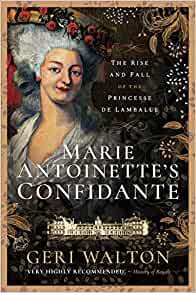
Marie Antoinette’s Confidante: The Rise and Fall of the Princesse de Lamballe
Paperback – 30 April 2020 (UK) & 2 August 2020 (US)
Marie Antoinette has always fascinated readers worldwide. Yet perhaps no one knew her better than one of her closest confidantes, Marie Thrse, the Princess de Lamballe. The Princess became superintendent of the Queens household in 1774, and through her relationship with Marie Antoinette, a unique perspective of the lavishness and daily intrigue at Versailles is exposed. Born into the famous House of Savoy in Turin, Italy, Marie Thrse was married at the age of seventeen to the Prince de Lamballe; heir to one of the richest fortunes in France. He transported her to the gold-leafed and glittering chandeliered halls of the Chteau de Versailles, where she soon found herself immersed in the political and sexual scandals that surrounded the royal court. As the plotters and planners of Versailles sought, at all costs, to gain the favour of Louis XVI and his Queen, the Princess de Lamballe was there to witness it all. This book reveals the Princess de Lamballes version of these events and is based on a wide variety of historical sources, helping to capture the waning days and grisly demise of the French monarchy. The story immerses you in a world of titillating sexual rumours, blood-thirsty revolutionaries, and hair-raising escape attempts and is a must read for anyone interested in Marie Antoinette, the origins of the French Revolution, or life in the late 18th Century.
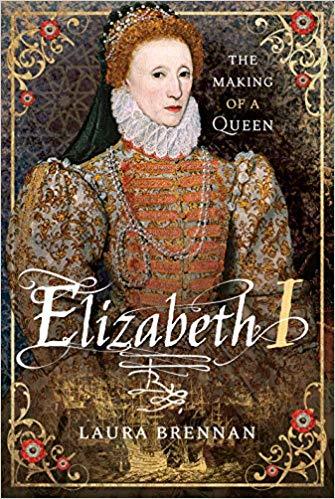
Elizabeth I: The Making of a Queen
Hardcover – 30 April 2020 (UK) & 2 August 2020 (US)
Elizabeth I is arguably one of the greatest monarchs and women of English history. Against an uncertain political and religious backdrop of post-reformation Europe she ruled at the conception of social modernisation, living in the shadow of the infamy of her parents reputations and striving to prove herself an equal to the monarchs who had gone before her. This book seeks to explore some of the key events of her life both before and after she ascended to the English throne in late 1558\. By looking at the history of these selected events, as well as investigating the influence of various people in her life, this book sets out to explain Elizabeth’s decisions, both as a queen and as a woman. Amongst the events examined are the death of her mother, the role and fates of her subsequent step-mothers, the fate of Lady Jane Grey and the subsequent behaviour and reign of her half sister Mary Tudor, along with the death of Amy Dudley, the return of Mary Queen of Scots to Scotland, the Papal Bull and the Spanish Amanda.
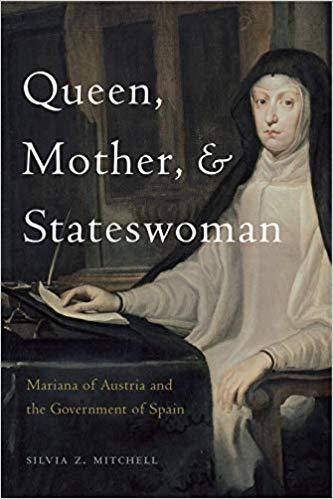
Queen, Mother, and Stateswoman: Mariana of Austria and the Government of Spain
Paperback – 15 April 2020 (US & UK)
When Philip IV of Spain died in 1665, his heir, Carlos II, was three years old. In addition to this looming dynastic crisis, decades of enormous military commitments had left Spain a virtually bankrupt state with vulnerable frontiers and a depleted army. In Silvia Z. Mitchell’s revisionist account, Queen, Mother, and Stateswoman, Queen Regent Mariana of Austria emerges as a towering figure at court and on the international stage, while her key collaborators—the secretaries, ministers, and diplomats who have previously been ignored or undervalued—take their rightful place in history.
Mitchell provides a nuanced account of Mariana of Austria’s ten-year regency (1665–75) of the global Spanish Empire and examines her subsequent role as queen mother. Drawing from previously unmined primary sources, including Council of State deliberations, diplomatic correspondence, Mariana’s and Carlos’s letters, royal household papers, manuscripts, and legal documents, Mitchell describes how, over the course of her regency, Mariana led the monarchy out of danger and helped redefine the military and diplomatic blocs of Europe in Spain’s favor. She follows Mariana’s exile from court and recounts how the dowager queen used her extensive connections and diplomatic experience to move the negotiations for her son’s marriage forward, effectively exploiting the process to regain her position.
A new narrative of the Spanish Habsburg monarchy in the later seventeenth century, this volume advances our knowledge of women’s legitimate political entitlement in the early modern period. It will be welcomed by scholars and students of queenship, women’s studies, and early modern Spain.
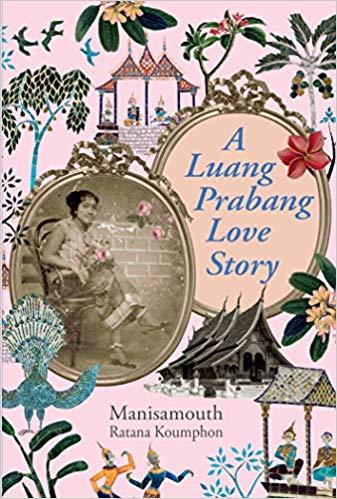
A Luang Prabang Love Story
Paperback – 15 April 2020 (US) & 26 March 2020 (UK)
In 1930s Luang Prabang, the beautiful and demure Kham-Phiou was much admired. On a New Year’s Day, the life of the aristocratic young woman changed when she caught the eye of a sophisticated older man – Prince Souvanna Phouma. The prince fell madly in love with Kham-Phiou and was determined to marry her against all odds. His family wanted a marriage within the dynasty, while her widowed mother feared Palace intrigues. After the wedding, life in the prince’s family home was difficult, but Kham-Phiou began to adapt until the prince decided they should move to Vientiane for the sake of his career. The tale of the tragic love story spans over half a century and is set against the little-known backdrop of old-world Laos where ancient customs and superstitions still held sway.
In this charming and moving personal account incorporating the social history of Laos, Manisamouth, granddaughter of Kham-Phiou, brings her grandmother’s untold story to life, accompanied by evocative black and white photographs, family trees of the Luang Prabang Royals and Kham-Phiou’s lineage, and includes a section on Lao history.

Japan’s Imperial House in the Postwar Era, 1945–2019 (Harvard East Asian Monographs)
Hardcover and Paperback – 18 February 2020 (US) & 28 April 2020 (UK)
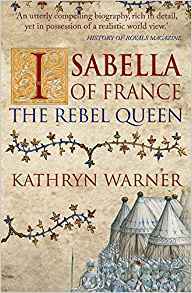
Isabella of France: The Rebel Queen
Paperback – 15 January 2020 (UK) & 1 April 2020 (US)
Isabella of France married Edward II in January 1308, and afterwards became one of the most notorious women in English history. In 1325, she was sent to her homeland to negotiate a peace settlement between her husband and her brother Charles IV, king of France. She refused to return. Instead, she began a relationship with her husband s deadliest enemy, the English baron Roger Mortimer. With the king s son and heir, the future Edward III, under their control, the pair led an invasion of England which ultimately resulted in Edward II s forced abdication in January 1327. Isabella and Mortimer ruled England during Edward III s minority until he overthrew them in October 1330.
A rebel against her own husband and king, and regent for her son, Isabella was a powerful, capable and intelligent woman. She forced the first ever abdication of a king in England, and thus changed the course of English history. Examining Isabella s life with particular focus on her revolutionary actions in the 1320s, this book corrects the many myths surrounding her and provides a vivid account of this most fascinating and influential of women.
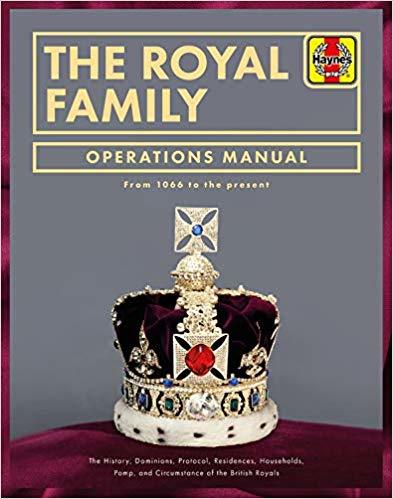
The Royal Family Operations Manual: From 1066 to the present. The history, dominions, protocol, residences, households, pomp and circumstance of the British Royals
Hardcover –24 March 2020 (US) & 6 April 2020 (UK)
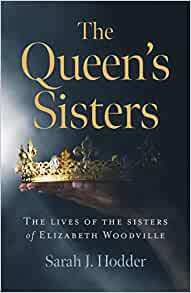
The Queen’s Sisters: The lives of the sisters of Elizabeth Woodville
Paperback – 27 March 2020 (UK) &1 April 2020 (US)
Whether Queen or commoner, the lives of women throughout history is a fascinating study. Elizabeth Woodville, ‘The White Queen’, managed to make the transition from commoner to Queen and became the epitome of medieval heroines the commoner who married a King. When she became the wife of Edward IV her actions changed the life of her entire family. Vilified both by their contemporaries and by many historians since, the Woodville family were centre stage during the reigns of Edward IV and Richard III. Elizabeth Woodville became the ancestress of future Kings and Queens. This book takes a fresh look at the lives of Elizabeth’s sisters. Although information on them is scarce, by looking at the men they married, their families, the places they lived and the events that they lived through we can catch a glimpse of their lives. Each sister has their own story to tell and they may not have achieved the dizzying heights that their sister did, but they are all fascinating women.
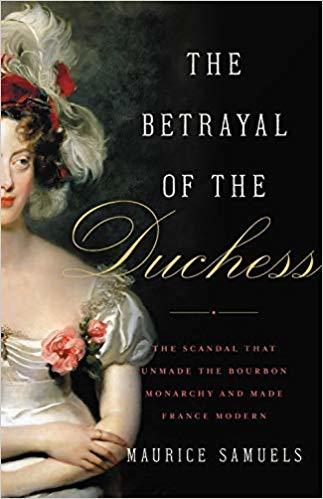
The Betrayal of the Duchess: The Scandal That Unmade the Bourbon Monarchy and Made France Modern
Hardcover – 14 April 2020 (US & UK)
The year was 1832 and the French royal family was in exile, driven out by yet another revolution. From a drafty Scottish castle, the duchesse de Berry — the mother of the eleven-year-old heir to the throne — hatched a plot to restore the Bourbon dynasty. For months, she commanded a guerilla army and evaded capture by disguising herself as a man. But soon she was betrayed by her trusted advisor, Simon Deutz, the son of France’s Chief Rabbi. The betrayal became a cause célèbre for Bourbon loyalists and ignited a firestorm of hate against France’s Jews. By blaming an entire people for the actions of a single man, the duchess’s supporters set the terms for the century of antisemitism that followed.
Brimming with intrigue and lush detail, The Betrayal of the Duchess is the riveting story of a high-spirited woman, the charming but volatile young man who double-crossed her, and the birth of one of the modern world’s most deadly forms of hatred.
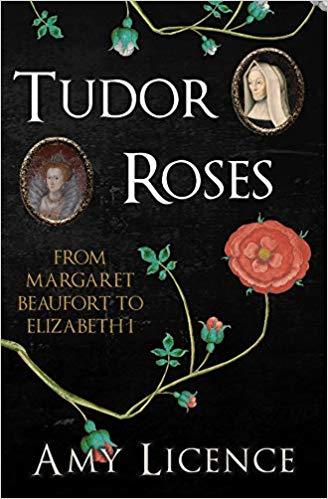
Tudor Roses: From Margaret Beaufort to Elizabeth I
Hardcover – 1 April 2020 (US) & 15 March 2021 (UK)
All too often, a dynasty is defined by its men, with the women depicted as shadowy figures whose value lies in the inheritance they brought, or the children they produced. Yet the Tudor dynasty is full of fascinating women, from Margaret Beaufort, who emerged triumphant after years of turmoil; Elizabeth of York’s steadying influence; Catherine of Aragon and Anne Boleyn, whose rivalry was played out against the backdrop of the Reformation; to Mary I and Elizabeth, England’s first reigning Queens. Many more women danced the Pavane under Henry VIII’s watchful eye or helped adjust Elizabeth’s ruff. These were strong, powerful women, whether that was behind the scenes or on the international stage. Their contribution took England from the medieval era into the modern. It is time for a new narrative of the Tudor women: one that prioritizes their experiences and their voices.
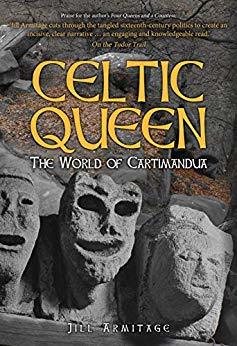
Celtic Queen: The World of Cartimandua
Hardcover – 15 January 2020 (UK) & 1 April 2020 (US)
The British queens Cartimandua and Boudicea were two Celtic noblewomen, recorded by classical writers as part of a tradition of women who showed particular courage, ambition, and political skill, and who were just as formidable in war as their husbands. They took on the status of Celtic Goddesses and were central players in the struggle against the Roman annexation of Britain. Boudicea led the rebellion against the Romans, but her reputation may be largely symbolic: to Britons and Romans alike, she came to represent matronly honor and heroic resistance, fighting on behalf of her defiled daughters. But using historical and archaeological evidence, this book uncovers the much weightier story of the Celtic Queen Cartimandua, the independent ruler of the powerful Brigante tribe whose territory was the single largest Celtic kingdom in Britain. Cartimandua’s leadership in battle and political influence were probably much greater than Boudiceas, yet her life has since been written out of history. Unlike Boudica, wife of King Prasutagus of the Iceni tribe, Cartimandua was the regent of the Brigante tribe in her own right. Her tribe prospered in the new Imperial world and she held her position as queen until AD69. But she was seen as a shameless adulteress after an open affair with her husband’s arms-bearer. Such sexual liberation was normal for powerful Celtic women but it scandalized Roman society. With many references to popular Celtic culture, their gods, beliefs, art and symbolism, as well as living conditions and the hillforts that would have been Cartimandua’s headquarters, this book offers an insight into the life of this fascinating woman and the Celtic/Romano world in which she lived.
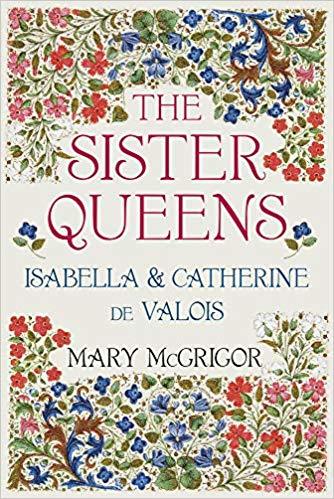
The Sister Queens: Isabella & Catherine de Valois
Paperback – 30 September 2019 (UK) & 1 April 2020 (US)
Isabella de Valois was three years old in 1392 when her father suddenly went mad. Less than four years later, she was married by proxy to King Richard II and arrived in England with a French retinue and her doll’s house. Richard’s brutal murder by his cousin, the future Henry IV, forced Isabella’s desperate return to France where she found her country fatally divided. Isabella’s sister, Catherine de Valois, became the bride of Henry V and is unique in history for being the daughter of a king, the wife of a king, the mother of a king and the grandmother of a king. Like her sister, Catherine was viewed as a bargaining chip in times of political turmoil, yet her passionate love affair with the young Owain Tudor established the entire Tudor dynasty and set in motion one of the most fascinating periods of British history.
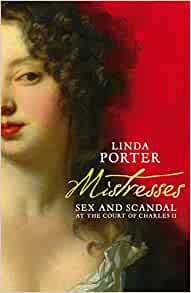
Mistresses: Sex and Scandal at the Court of Charles II
Hardcover – 16 April 2020 (UK) & Unknown (US)
According to the great diarist, John Evelyn, Charles II was ‘addicted to women’, and throughout his long reign a great many succumbed to his charms. Clever, urbane and handsome, Charles presided over a hedonistic court, in which licence and licentiousness prevailed.
Mistresses is the story of the women who shared Charles’s bed, each of whom wielded influence on both the politics and cultural life of the country. From the young king-in-exile’s first mistress and mother to his first child, Lucy Walter, to the promiscuous and ill-tempered courtier, Barbara Villiers. From Frances Teresa Stuart, ‘the prettiest girl in the world’ to history’s most famous orange-seller, ‘pretty, witty’ Nell Gwynn and to her fellow-actress, Moll Davis, who bore the last of the king’s fifteen illegitimate children. From Louise de Kéroualle, the French aristocrat – and spy for Louis XIV – to the sexually ambiguous Hortense Mancini. Here, too, is the forlorn and humiliated Queen Catherine, the Portuguese princess who was Charles’s childless queen.
Drawing on a wide variety of original sources, including material in private archives, Linda Porter paints a vivid picture of these women and of Restoration England, an era that was both glamorous and sordid.
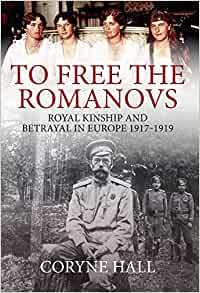
To Free the Romanovs: Royal Kinship and Betrayal in Europe 1917-1919
Paperback – 15 April 2020 (UK) & 1 August 2020 (US)
King George V s role in the withdrawal of an asylum offer was covered up. Britain refused to allow any Grand Dukes to come to England, a fact that is rarely explored.
When Russia erupted into revolution, almost overnight the pampered lifestyle of the Imperial family vanished. Within months many of them were under arrest and they became enemies of the Revolution and the Russian people . All showed great fortitude and courage during adversity. None of them wanted to leave Russia; they expected to be back on their estates soon and to live as before. When it became obvious that this was not going to happen a few managed to flee but others became dependent on their foreign relatives for help.
For those who failed to escape, the questions remain. Why did they fail? What did their relatives do to help them? Were lives sacrificed to save other European thrones? After thirty-five years researching and writing about the Romanovs, Coryne Hall considers the end of the 300-year-old dynasty and the guilt of the royal families in Europe over the Romanovs bloody end. Did the Kaiser do enough? Did George V? When the Tsar s cousins King Haakon of Norway and King Christian of Denmark heard of Nicholas s abdication, what did they do? Unpublished diaries of the Tsar s cousin Grand Duke Dmitri give a new insight to the Romanovs feelings about George V s involvement.
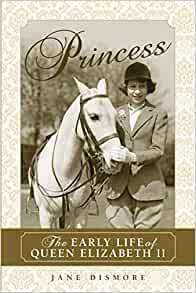
Princess: The Early Life of Queen Elizabeth II
Paperback – 1 April 2020 (UK) & 1 February 2020 (US)
In November 2017 the Queen and the Duke of Edinburgh celebrated their 70th wedding anniversary. As a 13-year-old Princess, she fell in love with Prince Philip of Greece, an ambitious naval cadet, and they married when she was 21; when she suddenly became Queen at 25, their lives changed forever. Philip has been her great support, but fortunately she also had a solid foundation that helped prepare her for a life dedicated to duty. With previously unpublished material and unique memories from friends and relatives who have known her since childhood, this book looks afresh and in richer depth at her life as Princess, glittering yet isolating. Vivid detail and anecdotes reveal more about her, the era in which she grew up and the people who shaped her life. The archives of royal confidante Lady Desborough and Private Secretary Sir Alec Hardinge reveal unseen letters from the Princess and the royal family, giving intimate insights into their lives and minds.
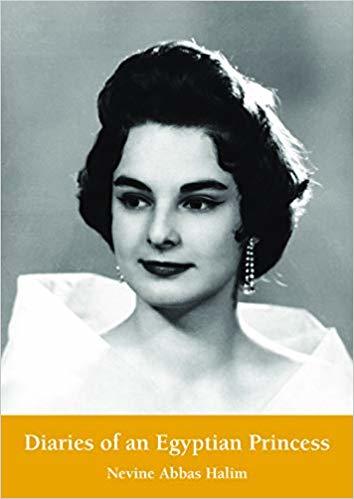
Diaries of an Egyptian Princess
Hardcover – 15 November 2019 (UK) & 10 April 2020 (US)
Princess Nevine Halim is a direct descendant of the dynasty that ruled Egypt from 1805 until the abdication of King Farouk in the wake of the Free Officers coup in 1952. The eldest of three children, she was born in Alexandria on 30 June 1930, the great-great-granddaughter of Muhammad Ali Pasha on her father’s side and the great-granddaughter of Khedive Ismail on her mother’s side. Drawing on her own diary, as well as those of her mother and grandmother, she takes us on a journey from the First to the Second World War, from Egypt to Europe and the United States, from a world of glamor, wealth, and privilege to the fugitive existence of the exile and social outcast after 1952. We also meet her father, Abbas Halim, the charming rebel prince who clashed with King Fuad for championing the rights of workers, as well as many other members of the Egyptian royal family and a glittering host of international royals, politicians, and film stars. Packed with royal gossip and political intrigue, with tales of young love and fashionable society, and of princes and princesses dancing perilously close to the edge of a way of life that would one day fall apart and then vanish, Diaries of an Egyptian Princess is an event-filled account of an endlessly fascinating epoch in modern Egyptian history.
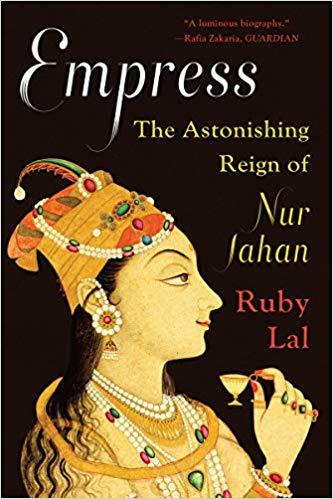
Empress: The Astonishing Reign of Nur Jahan
Paperback – 29 May 2020 (UK) & 28 April 2020 (US)
In 1611, thirty-four-year-old Nur Jahan, daughter of a Persian noble and widow of a subversive official, became the twentieth and favourite wife of the Emperor Jahangir who ruled the Mughal Empire. An astute politician as well as a devoted partner, she issued imperial orders; coins of the realm bore her name. When Jahangir was imprisoned by a rebellious nobleman, the Empress led troops into battle and rescued him. The only woman to acquire the stature of empress in her male-dominated world, Nur was also a talented dress designer and innovative architect whose work inspired her stepson’s Taj Mahal. Nur’s confident assertion of talent and power is revelatory; it far exceeded the authority of her female contemporaries, including Elizabeth I. Here, she finally receives her due in a deeply researched and evocative biography.
The post Book News April 2020 appeared first on History of Royal Women.
March 19, 2020
The Year of Queen Wilhelmina – The death of her mother Queen Emma
Queen Emma, born Emma of Waldeck and Pyrmont, was born on 2 August 1858 and was just 20 years old when she married the 61-year-old King William III of the Netherlands. Their only daughter and the future Queen of the Netherlands was born on 31 August 1880.
When William died on 23 November 1890, Emma became regent for their 10-year-old daughter. She oversaw the education of her daughter while running the country, as a foreigner and a woman at that. She handed over the reins of government upon her daughter’s 18th birthday, and by then, she looked much older than her 32 years. To thank her for her regency, the public gave her 300,000 guilders, most of which she spent on founding a tuberculosis charity – a disease which had killed her younger sister. When her daughter married in 1901, Emma moved to the Lange Voorhout Palace. She would also often spend her summers at Noordeinde Palace.
From 1909 until 1927, she was once more appointed as regent in case Wilhelmina died during the minority of her daughter Juliana. Wilhelmina’s husband, Henry, was believed to be less suited to the task.
In March 1934, Emma fell ill with a cold that developed into pneumonia. When it was believed that the danger had passed, Emma quietly passed away in her sleep during the early morning of 20 March. She was 75 years old.
Wilhelmina later wrote in her memoirs, “This time, however, we soon received a telephone call from the doctor, who advised me to return immediately because Mother had suddenly fallen ill and her condition gave rise to anxiety. We left at once. A few tense days followed. Juliana and I were with her at the Voorhout day and night, and Henry paid several short visits, with the doctor’s consent. On the 20th of March, God called her to Him. On the 27th, we accompanied her to her last resting-place in the vault of the Nieuwe Kerk in Delft, where she lies beside my father. Since the end of her Regency, she had devoted herself entirely to suffering humanity. The warmth of her interest and her intuitive understanding of the circumstances of those who suffered as well as of those who nursed them caused many a heart to rejoice in the course of the years. Mother’s feelings went out to all, and she was a regular visitor in all classes of society.”
She added, “The news of her death caused general grief and regret among our people. We were particularly moved by the small tokens of love which were laid besides her bier, and perhaps even more by the expressions of those who came to say a last farewell. We, as members of the family, were affectionately included in this spontaneous demonstration of love. At her funeral, the national anthem of Waldeck-Pyrmont was played for the last time.”1
On 30 March, Wilhelmina wrote to her former governess Miss Winter, “For me, the sun for ever has gone, you will understand.”2
Embed from Getty Images
Embed from Getty Images
 Entrance to the royal crypt – Photo by Moniek Bloks
Entrance to the royal crypt – Photo by Moniek BloksEmma was interred in the royal crypt in Delft.
The post The Year of Queen Wilhelmina – The death of her mother Queen Emma appeared first on History of Royal Women.
March 18, 2020
Lady in Waiting: My Extraordinary Life in the Shadow of the Crown by Anne Glenconner Book Review
I went into Lady in Waiting: My Extraordinary Life in the Shadow of the Crown with great expectations, having even seen the witty Lady Anne on The Graham Norton Show telling him all about her honeymoon.
Lady Anne was the daughter of Thomas Coke, 5th Earl of Leicester and Lady Elizabeth Yorke. She was a playmate of a young Queen Elizabeth II and her sister Princess Margaret as her parents were acquainted with King George VI and Queen Elizabeth. She married Colin Tennant, the future 3rd Baron Glenconner in 1956. They went on to have five children together – three sons and twin girls.
It was Colin who bought Mustique, later made famous by the presence of Princess Margaret. In 1971, Anne became an Extra Lady-in-Waiting to Princess Margaret.
Lady in Waiting: My Extraordinary Life in the Shadow of the Crown is not just about Anne’s time as Princess Margaret’s lady-in-waiting and we are taken through Anne’s entire life as an aristocrat mingling with royalty. Her married life with the eccentric Colin left me feeling a bit like, “why didn’t you get the hell out of there?” but perhaps that was simply not done. Her attitude towards her son’s addiction also left me slightly baffled. The stories about Princess Margaret were wonderful though and it’s lovely to get this point-of-view.
Lady in Waiting: My Extraordinary Life in the Shadow of the Crown by Anne Glenconner is available now in both the UK and the US.
The post Lady in Waiting: My Extraordinary Life in the Shadow of the Crown by Anne Glenconner Book Review appeared first on History of Royal Women.



